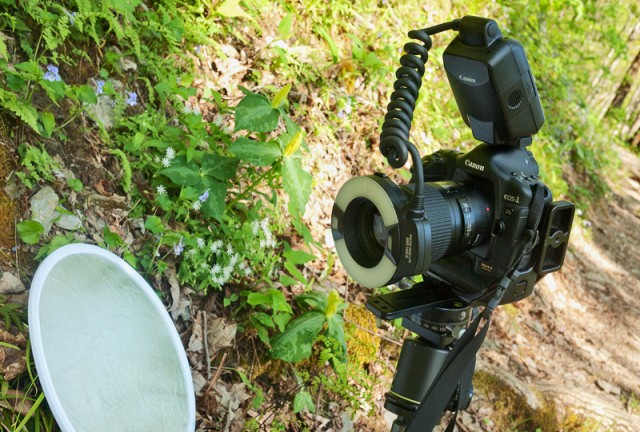
Updated 2012: This blog post was originally written two years ago, in spring of 2010. The information here is still very valid and useful, but in the past couple of years I’ve adopted a more “minimalist” approach to photography, and especially wildflower photos. The main difference is that I’m now using a very lightweight camera, which I find very enjoyable for Smoky Mountains hiking. I currently use a Panasonic Lumix GH2, which is a micro-four-thirds system. This allows me to carry a camera with a 600mm equivalent lens in the palm of one hand! This is fabulous for all kinds of photography, especially wildlife and wildflower photos.
So, although I still use the system pictured above for serious wildflower portraits — a full-frame Canon DSLR with ring-flash and tripod — my every day gear these days is the small GH2 on a monopod (which doubles as my hiking stick!) with the 14-140 lens. This gives me a 28-280 zoom in 35mm equivalent terms, and I find it gives very good results for wildflower close-ups. I’ve added a typical shot from this camera/lens at the bottom of this page. It doesn’t give you that classic “macro” look with the extreme narrow depth of field, but it gives very good results … and it’s so much fun to use! And I still wouldn’t leave home without the 12″ LiteDisc in my back pocket!
There are several issues to consider when photographing wildflowers in the Smoky Mountains. First, many of them are tiny, so to get a real good portrait you will need a macro lens. I find that the 100mm is most useful, although I also use a 180mm. In general, macro lenses are reasonably priced and tend to be of very high quality.
Second, although it may seem counter-intuitive, the sun is not your friend. A flower bathed in direct sunlight will be harshly lit with shadows that are too dark for your camera to contend with. There are exceptions to this of course, such as the golden, syrupy light of early morning or sunset. But in general, you will want something to shade the plant. I carry a 12″ disc called a LiteDisc by Fotoflex, which will collapse into a small disc that fits in my back pocket. You can get one that is silver on one side (pictured above) and gold on the other side. These can also be used to reflect light into the scene. Or you can get a translucent disc that will turn direct sunlight into a diffused, soft light. Or you might just try an umbrella!
Third, now that you have blocked the sunlight, you will need to provide your own light. In the picture above you can see a ring flash attached to the front of my macro lens. The advantage of the ring flash is that the camera will automatically bathe the flower in a perfect light, giving you great exposures every time. You will not be able to get the same effect from a normal flash attachment. An alternative to the ring flash is a small portable “soft box.” Or the no-cost solution would be to go out on rainy days. But most of the time you will have no control over the lighting conditions, so by carrying these items you will always be able to create a perfect lighting environment.
Fourth, the problem that is the most difficult to solve is wind. Again, these are tiny, delicate blossoms, and you are down on your hands and knees with a magnifying lens. You’ve carefully composed a perfect view of this miniature world, and suddenly those little plants start waving about in just a slight breeze. There’s not much to do except wait it out. Stick your eyes in the viewfinder until your knees give out, and if there is just a second or two of calm, snap the picture. Also, early mornings tend to be calmer, and as the day heats up it creates air currents. Also, if the forecast is for wind or an approaching storm front, postpone your trip if you can.
In the photo above I was interested in the little white Star Chickweed blossoms in a clump underneath the Yellow Trillium on the Chestnut Top Trail. Below is the final image. Click on the image above or below for a larger version.
That’s my photo tip for getting great wildflower pictures. Please stop in and visit me to see the complete display of Smoky Mountain Photography at the William Britten Gallery in Gatlinburg, TN.
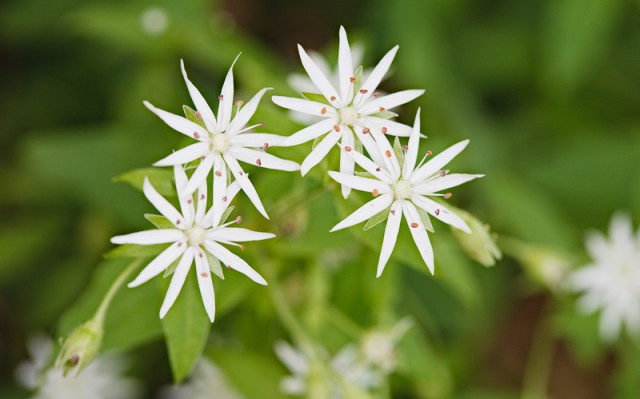
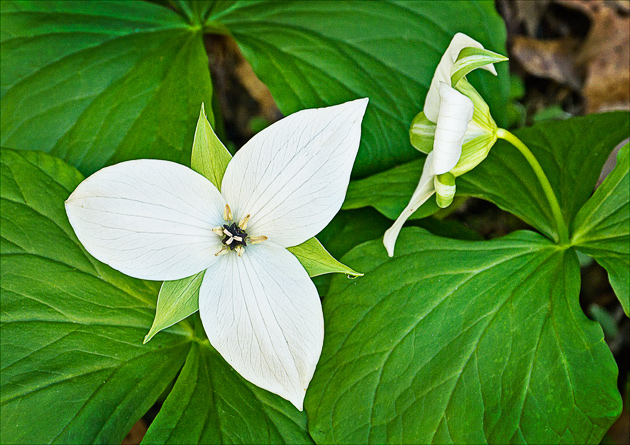
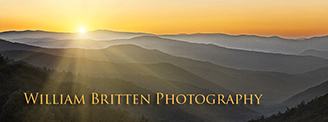
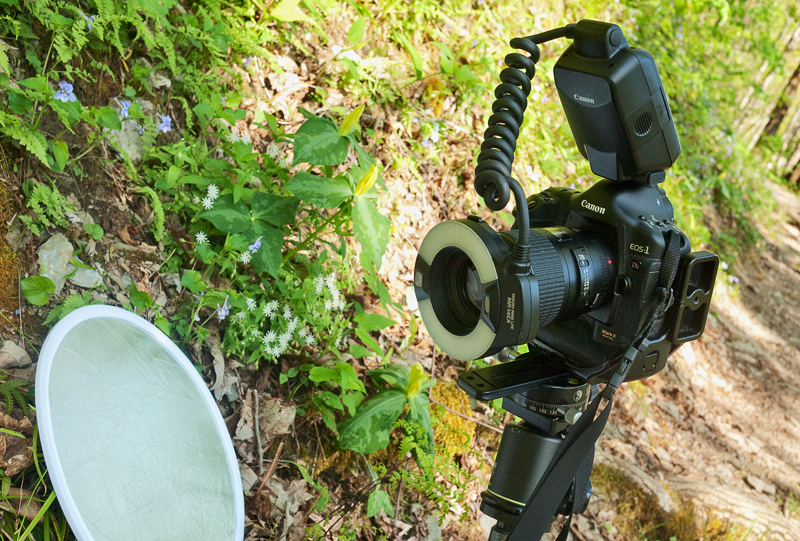
Really good info. I appreciate it. Macro lense. Can you get those for digital and also for 35mm cameras. What do you use, digital or 35mm? Can digital now come close to 35mm or is that still some time off in the future? Also can you get good quality images of wildflowers using a cell phone camera? Appreciate any info you could supply. Thanks, Jerry
I use a 35mm Canon digital camera. Lots of small digital cameras come with a “macro” setting. With a true macro lens on a digital SLR you can really get sharp and up-close. As for cell phones, use mine for fun posting to facebook, but not for a serious photo.
Thank you so much for posting your pictures and comments. Also thank you for the good information on photographing wildflowers. I have tried to get some good pictures of wildflowers and I have decided that the way to create a breeze is to get your camera out!
Bill
I see that you use a ring flash. I am considering buyng one for wildflower photography. Do you consider this the best bet for the job?
Thanks
Jeff
Jeff – The ring flash puts a very nice soft light on any macro subject. I don’t always use it, though. Lots of times a some soft light with one of the diffuser rings is just right.
What monopod do you use? Thanks so much for sharing your wonderful work and tips!
Pam – I use a Slik 381 monopod with a little ball head from Really Right Stuff. Not cheap! But I realized years ago that a quality tripod was worth it.